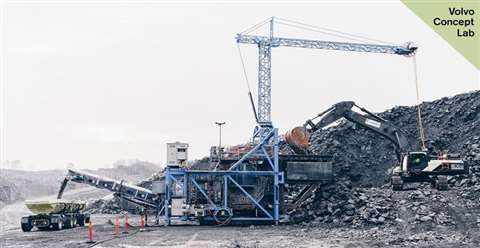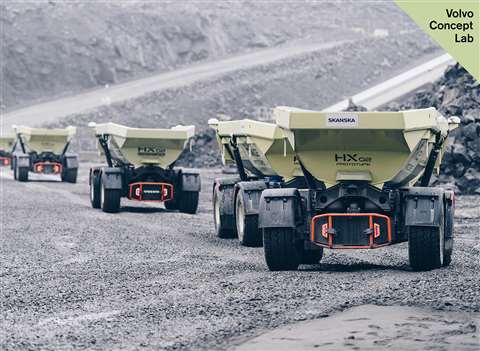Results in from electric site research project
22 November 2018

A test electric construction site, operated by Volvo Construction Equipment (Volvo CE) and its customer Skanska, has resulted in a 98% reduction in carbon emissions, a 70% reduction in energy costs and a 40% reduction in operator costs, according to Volvo CE.
The Swedish-based original equipment manufacturer and Skanska have been testing the viability of the electric site research project over the last ten weeks at Skanska’s Vikan Kross quarry, near Gothenburg, Sweden.
The results show the potential for a 25% reduction in total cost of operations. However, this figure is just a prediction as the machines being used are prototypes.
“Over the last ten weeks, we’ve made incredible progress, learnt a lot and seen huge potential in the electric site solution’s environmental, efficiency, safety and cost benefits,” said Uwe Müller, chief project manager for the electric site at Volvo CE.
“In fact, we have decided that we want to learn more, so we will extend our test period with Skanska until the end of the year. The results we have seen so far confirm that this research project is a step towards transforming the quarry and aggregates industry and creating emission-free quarries.”
The project aims to electrify each transport stage in a quarry – from excavation to primary crushing, and transport to secondary crushing. It incorporates electric and autonomous prototype Volvo CE machines, new work methods, and site management systems, which together form a complete site solution. New technology encompasses machine and fleet control systems and logistic solutions for electric machines in quarries.
The electric site project involves eight HX2 autonomous, battery-electric load carriers, which transport the material from the primary mobile crusher up to the secondary static crusher. The second-generation prototypes incorporate shared technologies and components from the Volvo Group. They use a lithium ion battery to power two electric motors which drive the machine; the hydraulics are driven by an additional electric motor. The HX2 is fitted with a vision system, which allows it to detect humans and obstacles. It can follow an adjustable, pre-programed GPS path.

According to Volvo CE, the LX1 prototype electric hybrid wheel loader delivered more than a 50% improvement in fuel efficiency at the quarry, as well as significant reductions in emissions and noise pollution, compared to its conventional counterparts. Its job was to organize the piles of material at the site.
The LX1 is a series hybrid that incorporates a driveline that consists of electric drive motors mounted at the wheels, electric-driven hydraulics, an energy storage system, a smaller diesel engine and new machine architecture, including a new design of the lifting unit. It’s this combination that enables the substantial gain in fuel efficiency.
The EX1 70-ton, dual-powered, cable-connected excavator prototype loaded the primary crusher at the quarry. The base machine for the EX1 is a Volvo EC750 crawler excavator that has been upgraded to incorporate an electric motor in addition to the diesel engine.
At the quarry, the machine was plugged into the grid, so zero emissions were emitted. If the cable is connected, the EX1 will automatically start in electric mode. If it’s not, it will start in diesel mode.
The EX1 is operated in the same way as a conventional Volvo excavator.




